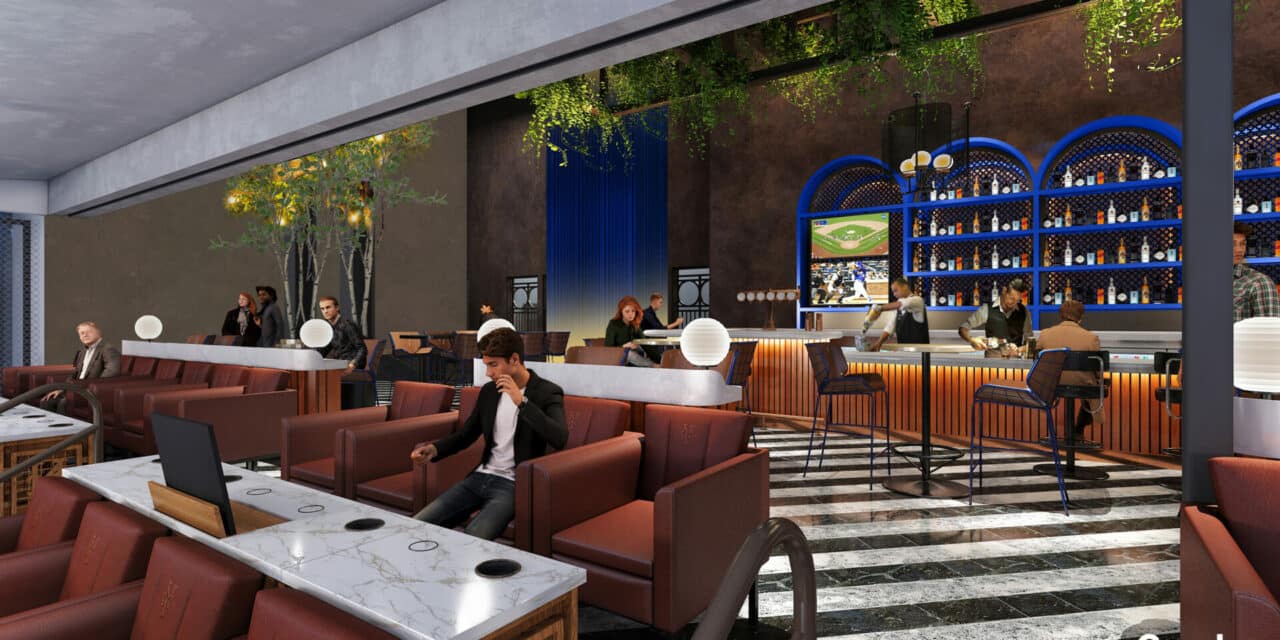IT’S A CADDY: The Cadillac Club at Payson’s, a new field-level outfield space at Citi Field, honors Joan Whitney Payson, the New York Mets’ original owner. (Courtesy Gensler)
Retrofits bring greater variety of seating options
The New York Mets are in the early stages of reshaping Citi Field, a ballpark whose seating bowl has not been upgraded since it opened in 2009. On Thursday, Opening Day at the park, fans will see two new premium clubs, a new left field flex space and a pair of revamped suites behind home plate.
The improvements to the bowl are the first phase of a master plan extending over the next three years to refresh the 41,800-capacity stadium under team owner Steve Cohen.
After opening its doors 14 years ago, Citi Field went largely untouched under the Wilpon family, the Mets’ previous owners. Now, 2.5 years after Cohen completed a $2.4 billion purchase of the team, he’s committed to spending tens of millions of dollars to bring the stadium up to speed with other MLB parks of its generation that have undergone renovations to meet the needs of younger fans.
As construction butts up against Opening Day, the total cost of the first phase remains a moving target, but it remains on time and on budget, and the sell-through rate on the revenue side has exceeded all projections, said Jeff Deline, the Mets’ executive vice president and chief revenue officer.
Deline is spearheading the project in tandem with sports architect Gensler, which designed the initial upgrades and Shawmut Design and Construction, the company building the new spaces. In addition, Oak View Group is consulting with the Mets on pricing for the new premium inventory and food service with ballpark concessionaire Aramark for the new clubs and suite renovations. OVG executive Tom Pistore, principally involved in the Citi Field renovations, worked with Deline for 24 years at Maple Leaf Sports and Entertainment in Toronto.
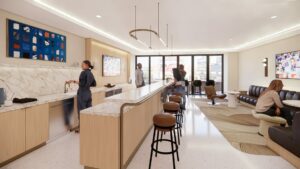
DELTA BRIDGE: The revamp of two suites behind home plate that are part of the Delta Club, shown here in a rendering. (Courtesy Gensler)
Together, all parties play a key role for transforming the fan experience at a facility that for the most part was restricted to general seating and suites. Nothing was ever really done to keep up with newer trends for how fans now consume baseball with more stratification in premium offerings and social spaces in general for fans attending games, Deline said.
“We’ve always been great from a food and beverage standpoint in offering a premier experience, but from where to sit and watch the game, it was unchanged and became stale over the last 10 to 12 years,” he said. “When Steve bought the team, we met and really connected. He asked me to explore the possibilities for what we can do differently that they haven’t thought of in the past.”
Deline said the Mets’ research to identify potential upgrades fell in line with what other MLB teams heard from their fans: the need for greater variety in seating, including loge boxes with smaller groups of seats, and hangouts customized with standing room and drink rails. Pistore said the team took a deliberate approach to product development in working with Gensler to meet the pent-up demand in a ballpark with too many traditional suites.
“They’re looking at areas where seating is a little soft,” said Ron Turner, a principal with Gensler and the firm’s global director of sports and entertainment. “That’s kind of what they’re doing with everything — where are the soft places in the ballpark that they can take to another level, do something different to create interest and upscale it.”
The results start with the new Cadillac Club at Payson’s, at field level behind the right field fence, named in part for Joan Whitney Payson, the Mets’ original owner. To help clear space for the 7,000-square-foot club, the Mets moved the right-field eight feet closer to home plate. The 150-seat club, the stadium’s highest-end space, is sold out, tied to multiyear leases. Tickets run $25,000 a person per season in the front row to $19,000 for seats in the third and fourth rows. The all-inclusive ticket package covers the cost of food and soft drinks, beer and wine and complimentary parking.
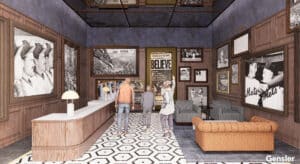
HIDDEN GEM: The Cadillac Club lobby, shown in a rendering, extends to a hidden door by the concierge desk opening to the lounge and four rows of premium seats. (Courtesy Gensler)
The club was designed as a speakeasy, coming on the heels of a similar theme for a premium space at the Texas Rangers’ Globe Life Field, which opened in 2020. At Citi Field, it replaces the old Honda Club, which was a basic dining area with few amenities, essentially a concrete floor with picnic tables and a limited menu. It does have street access, though, so it made sense to redevelop it as a secret hideaway, Deline said.
To access the Cadillac Club, patrons enter from a street entrance simply marked “Tickets,” and walk down a new brick hallway, adding to the smoky decor theme, to the concierge desk, where a push of a button opens a hidden door to the lounge. The room supports four rows of cushioned leather chairs that are part of the seating bowl. DreamSeat produced the chairs and consoles fronting the seats that contain refrigerated cup holders, small televisions and wireless chargers.
On a cold day, a movable glass wall can be activated that separates seating from the lounge, with patrons moving back and forth through doors at the aisles. The first two rows of open air seats are covered by a fixed roof and a retractable awning covers the last two rows. In that respect, the club is conducive for special events apart from game days, along with the other retrofits, Turner said.
Payson died in 1975 and is believed to be the first woman to independently own a big league team without inheriting it. She will be recognized through images on club signs showcasing the signature hats she wore to Mets games, said Don Williams, a senior associate with Gensler.
“It’s really cool that they have honored her in that way,” Williams said.
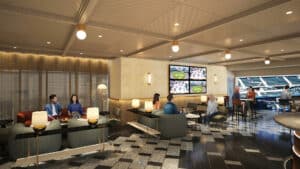
BUILD AN EMPIRE: The Empire Club, shown in a rendering, replaces five suites down the left-field line. (Courtesy Gensler)
Down the left field line, the Mets removed the five suites furthest from home plate that mostly sat vacant to develop the Empire Club on the suite level. The 60-person club, designed as art deco with a nod to the iconic Empire State Building, but with a sleek, contemporary look, supports the new loge box offering. Fans can buy groups of two to four seats, which are cushioned rolling chairs.
The average ticket price for the Empire Club, also an all-inclusive buy, is $27,500 a person per season, and the Mets are effectively sold out, said Jake Bye, the team’s senior vice president of marketing and premium. The Empire Club, similar to the Cadillac Club, has a retractable glass wall for protection against the elements.
“Our mix right now is 50% individual fans and 50% varied businesses,” Deline said. “It’s easier to manage a few seats than a suite 81 times a year, which is a lot of work and a full-time job. The Empire Club sold through before we did any media; it was basically word of mouth.”
In left-center field, situated midlevel, the Mets removed 430 seats to build the new Hijole Porch, a series of four platforms named for the tequila brand and Mets sponsor. It’s a flexible space that can be sold to one group or split into multiple single-game buys. The seating is a mix of sofas and drink rails that sell for $100 to $225 a person per game, depending on the opponent, with access to an open bar. A grab-and-go market in back of the landing had hot food options. It replaced a traditional concession stand.
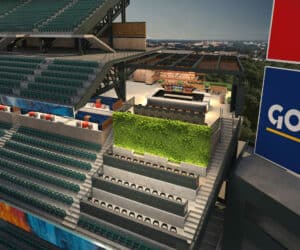
LANDING SPOT: The Hijole Porch, shown in a rendering, offers group packages and individual seats, plus an expansive view of Citi Field. (Courtesy Gensler)
A living green wall fronts the landing. The Mets took inspiration from Fenway Park’s Green Monster to develop their version of that signature feature at Citi Field after Deline attended a Boston Red Sox game and got to experience the top of the monster wall in left field. In Queens, the landing livens up what was previously a patio that became mostly dead space, but it’s still a spot with an incredible view of the whole ballpark, Deline said.
“Anyone can rent those spaces; even if you just bought two seats in that section, you’re able to walk over to the bar, hang out and look over center field,” he said. “It’s got that communal feeling. It covers the gamut of all the things we’re trying to build.”
The two suites behind home plate, flanking the owner’s suite, were old spaces that never got used. They’ve both been renovated with a new look and are sold for the season, with an upgraded food and drink program, including more premium spirits, Deline said.
Next year, up to 10 more suites on the original Sterling Club level, since rebranded for Delta Airlines, are targeted for a facelift, as well as the Clover Home Plate Club, plus other improvements for general admission fans.
“I was taught at my old job, you need something for all the fans,” Deline said. “If you bring too many premium products online, they end up competing with themselves. This is a test year, a way to whet our appetite to see what people were coveting. We took on a lot, but it will lay the foundation for what we do over the next three years.”
